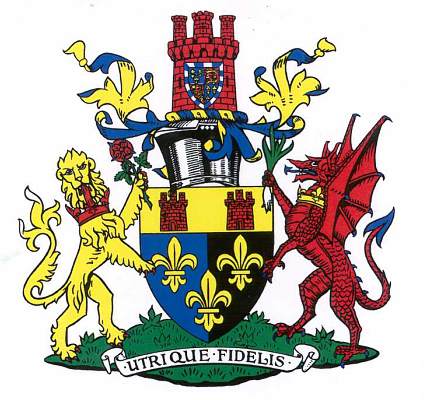Monmouthshire
| Heraldry of the World Civic heraldry of the United Kingdom |
MONMOUTHSHIRE
From 1974-1996 Gwent County Council
Official blazon
Arms : Per pale Azure and Sable three Fleurs-de-Lis Or on a Chief of the last two Towers triple towered Gules.
Crest : On a Wreath of Colours a Tower triple towered Gules charged with an Escutcheon of the Arms of Somerset that is to say quarterly first and fourth Azure three Fleurs-de-Lis Or second and third Gules three Lions passant guardant in pale Or all within a Border gobony Argent and Azure.
Supporters : On the dexter side a Lion guardant Or grasping with the interior paw a Rose Gules barbed seeded stalked and leaved proper and gorged with a Coronet composed of four Fleurs-de-Lis set upon a Rim also Gules and on the sinister side a Dragon of the last grasping with the interior claw a Leek also proper and gorged with a like Coronet Gold.
Motto : 'UTRIQUE FIDELIS' - Faithful to both
Origin/meaning
The arms were officially granted on January 28, 1948, transferred to Gwent County on April 16, 1975 and again on 18 October 1996 to the newly constituted Monmouthshire County Council
The gold fleur-de-lis upon blue and black are the Arms of the ancient Kingdom of Gwent. The castles are the arms of the ancient princes of Gwent and also refer to the many castles situated in the County.
The Somerset Coat of Arms shown on the castle forming the crest, refers to the connections of the Somerset family with the County. The castle itself refers to Raglan castle associated with Henry Somerset. The three towers that rise from it are for the three castles of Grosmont, Llantilo and Skenfrith.
The motto Utrique Fidelis (Faithful to Both) shows the county as faithful to both England and Wales, and the lion of England and the dragon of Wales, each holding its country's national emblem, illustrate this double allegiance. For many centuries there was some doubt as to which country Monmouthshire lay in.
Literature : Image and information provided by Laurence Jones.
